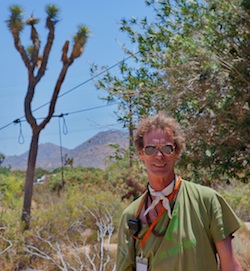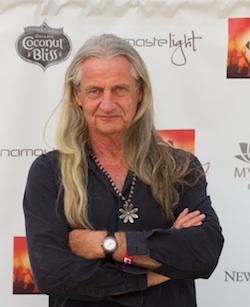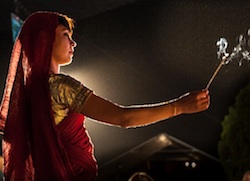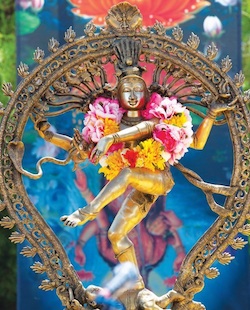 This year, Bhakti Fest will be lighting five candles on its birthday cake. The inspiration for the event began decades prior, when producer Sridhar Silberfein envisioned a spiritual gathering akin to the energy and community of Woodstock, yet with a more peaceful vibe and devotional attitude. You could say that even Woodstock had its roots in the sacred festivals where musicians would gather, sing, chant, and celebrate beside rivers or beneath trees, going back to ancient times with a legacy that continues even today.
This year, Bhakti Fest will be lighting five candles on its birthday cake. The inspiration for the event began decades prior, when producer Sridhar Silberfein envisioned a spiritual gathering akin to the energy and community of Woodstock, yet with a more peaceful vibe and devotional attitude. You could say that even Woodstock had its roots in the sacred festivals where musicians would gather, sing, chant, and celebrate beside rivers or beneath trees, going back to ancient times with a legacy that continues even today.
Since the first Bhakti Fest all-night chantfest beneath the Joshua trees in the high desert two hours outside of Los Angeles, the movement has grown to include festivals in both the fall and the spring, as well as an outpost in the Midwest. With smaller events at yoga studios dispersed around the country, a pilgrimage to India, and a widespread community supporting a long list of nonprofit organizations, this devotional gathering has had–and continues to have–a profound impact on the face of yoga in the West today.
In order to share the impact of Bhakti Fest, we spoke with a number of people behind the scenes and on stage at the festival who reflect on the music, the practice, and the movement.
Interviews by by Sarah Garney, Amy Gartenberg, Kasey Luber, and Julianna Gottschalk
Photos by Orville Griffiths and Richard Nesdale
Singer and devotee Karnamrita Dasi
Interviewed by Julianna Gottschalk
Karnamrita Dasi was raised on kirtan and mountain music, citing Srila Prabhupada as well as Dolly Parton and Wynonna Judd as influences.
LA YOGA: When did you begin kirtan?
KD: I was a baby when I was brought into the ashram. For seventeen years, my life included seven hours of kirtan every day. It was a great accident and a great blessing.
LA YOGA: How has Bhakti Fest changed the expression of the devotional music community in the US?
KD: It has brought up another flavor of devotion, allowing people to enter a mood that is extremely powerful. We have done this for generations and what kirtan really does is unify instead of compartmentalize our minds and hearts. Kirtan allows you a minute to be present; it allows you another way to serve.
Interviewed by Julianna Gottschalk
A steady presence backstage, the lanky jack-of-all-trades Kennedy Car has been a fixture at Bhakti Fest since the inaugural year.
LA YOGA: How have you seen the music evolve over the years?
KC: The first couple of years were very experimental with 12-18 piece ensembles playing on the second stage because everyone was so excited to get to know each other and want to play together. The music at Bhakti Fest is becoming a little more dance-oriented, as is the case in all genres of music. Right now, the bass is coming in as an activator of Kundalini energy and there is also a strong American influence. In the structure of the festival, every year gets better and better.
LA YOGA: How has festival been shifting over time?
KC: You see a traditional kirtan that has been around for thousands of years along with a new wave of youth with excitement and enthusiasm bringing their juju to the party.
Sacred Statue Vendor Manoj Chalam
Interviewed by Sarah Garney
The murtis are the statues, the symbolic representations of the archetypes of the deities, symbols of the divine.
LA YOGA: Tell me about the power of the murtis.
MC: The symbols of these archetypes pertain to your life and pop up at specific times to help you; there are practices you can do, such as meditating, chanting, and doing puja.
LA YOGA: How have you seen a change in the Bhakti festivals over the past five years?
MC: You may have different philosophies, different practices; however, there is only one ocean of love — Bhakti. The quality of Bhakti opens the heart, it is the oneness that it is manifesting everywhere.
LA YOGA: What would you like to share about your experience?
MC: I meet fantastic people from different backgrounds. It is a wonderful place to meet old friends. We, the vendors, go out there in the middle of the high altitude desert and we create beauty, shri, luminosity, then we tear it down after a few days; it is beautiful and also temporal. When you approach life as something beautiful and you cherish it, knowing that it’s temporary and you live in the moment, it is a wonderful experience.
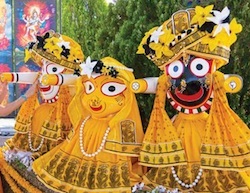
Tantra Teacher Dawn Cartwright
Interviewed by Amy Gartenberg
LA YOGA: How have you seen the level of inquiry and depth of practice expressed at Bhakti Fest?
DC: There is so much creativity flowing. And because we are all so close, we teach what we really feel in our hearts because we feel so safe. Everyone is sharing the deepest jewel in their heart.
LA YOGA: How has your personal practice been influenced by Bhakti Fest?
DC: To me Bhakti Fest isn’t a festival, it’s a family reunion! I am collaborating with people that I’ve met at Bhakti. My personal practice has flowered because they have given me a spiritual family.
LA YOGA: What do you hope people will take away from your class?
DC: When we love each other consciously, we are entering into a harmonious vibration. It has a sustainable loving pulse that nourishes the whole planet. I want people to tap into this and bring Bhakti into their everyday lives.
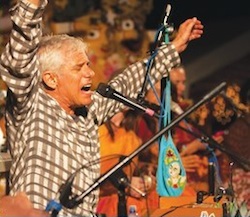
Interviewed by Sarah Garney
LA YOGA: What is unique about Bhakti Fest?
JU: The stage is really big, so I love filling it with friends. Even after all these years, I have various degrees of stage fright. When I surround myself with my friends, my village, my tribe, I don’t feel it. I feel like we are all in the band–not just the people on the stage but the people in the audience.
LA YOGA: How has that community unfolded over the past five years?
JU: I feel the community is becoming more family-like, rather than it being thousands of strangers coming to an amazing festival.
As the devotional heart develops over years, lifetimes, and centuries, the loving beautiful warm human-to-human heart grows along with it. It seems natural and obvious, but a lot of us forget this for a little while, then we remember it again.
Yoga Teacher Nubia Teixeira
Interviewed by Kasey Luber
Brazilian teacher Nubia Teixeira is married to Jai Uttal; together with their son Ezra, they travel the world, sharing practice.
LA YOGA: What, if anything, has changed in the yoga community since Bhakti Fest started five years ago?
NT: More awareness of the power of prayer and the community praying together.
LA YOGA: How can we integrate more Bhakti into our everyday lives?
NT: By waking up in the morning and spending a few minutes in prayer in the altar of the heart and asking the Divine to take over, “May I be an instrument of your Love and Serve your purpose.”
Interviewed by Kasey Luber
Global teacher Mark Whitwell studied with T. Krishnamacharya and his son T.K.V. Desikachar
LA YOGA: What does it mean to teach Bhakti?
MW: We communicate with each other and all of nature to and from our hearts. Love and devotion is natural, effortless, inspired — receiving to give, giving to receive, around and around as one spiraling, creative, nurturing source, the heart. The heart is the source of the body and mind. It is from where all opposites arise and return. To enjoy the heart’s flowering is Bhakti. By participating in the union of all opposites, the source of opposites is realized. This is the method of Bhakti.
My teacher Krishnamacharya would say: Without Hatha Yoga (the union of opposites) there is no Bhakti, and without Bhakti Yoga there is no Jnana Yoga (the yoga of understanding). All the different Yogas belong together in an integrated whole. He said it is only the Western mind that splits Yoga into different kinds, different camps. Finally, there is only one Yoga and it is Yoga adapted correctly to individual needs according to your body type, age, health, and cultural background. “Yogis are not built on assembly lines!” according to U G Krishnamurthi.
LA YOGA: How do you believe this Bhakti movement is impacting the world?
MW: God is in all ordinary conditions. Intimacy with all ordinary conditions of life is Bhakti. Bhakti is simply an ancient Sanskrit word from a time before religions arose for humanity. Bhakti is the primordial religious experience from which all doctrine arose. It means devotion to reality. Practitioners of all religions are Bhakti yogis. They need to be given the tools.
LA YOGA: Shyamdas is missed by all. What do you believe is the most important aspect of his legacy?
MW: Shyam Das was a Bhakti Yogi. He went to India 40 years ago and met his guru. He fell to his knees in India and became a serious scholar and practitioner of devotional culture. He never claimed to be a guru or great scholar. He never exploited the gullibility of the public with his knowledge. He was himself only, happy, always jolly and full of love for everyone he met. He travelled and taught in the West constantly in a passion to bring these deep understandings to the public. On reflection, I feel Shyam Das was a great saint who, like many of our saints, lived a very short life, delivering the message and then taking off. We know God through love of the ordinary life. I love Shyam Das with all my heart. What a friend. I am glad today he is still so visible in places like YouTube.
Interviewed by Kasey Luber
LA YOGA: The altars on stage are a beautiful expression of devotion. Please tell us how they came to be.
KD: Jagannath, Baladev, and Subhadra Devi are a Divine Trinity of Brothers and Sister expressing ecstatic joy. Their unique ancient forms are worshipped by diverse lineages in India, and especially by devotional dancers.
The Jagannath Deities that journey to Shakti and Bhakti Fest were carved from carefully selected trees in the Bhakti Eco-community, Saranagati Village in British Columbia. They were originally hand-carved and painted by Bhaktas for Rainbow Gatherings. “Rainbow Jagannath Deities” have been worshipped in cabins, tipis, and festival-forests, and now they find their way to Joshua Tree each year. They bring a taste of the Temple to the Stage.
I was originally given the service of restoring their worn and damaged surfaces. Amidst the restoration, the elders of Saranagati entrusted these special Deities to me to fulfill their destiny to attend outdoor festivals. Karnamrita Dasi drove them over the Canada/U.S. border, and I drive them with Prajna Vieira from the Bay Area for our desert festivals twice a year. It takes a tribe to place the Deities on the stage.
The fifth annual Bhakti Fest in the West will be held September 4-9 at the Joshua Tree Retreat Center. Bhaktifest.com
Felicia Tomasko has spent more of her life practicing Yoga and Ayurveda than not. She first became introduced to the teachings through the writings of the Transcendentalists, through meditation, and using asana to cross-train for her practice of cross-country running. Between beginning her commitment to Yoga and Ayurveda and today, she earned degrees in environmental biology and anthropology and nursing, and certifications in the practice and teaching of yoga, yoga therapy, and Ayurveda while working in fields including cognitive neuroscience and plant biochemistry. Her commitment to writing is at least as long as her commitment to yoga. Working on everything related to the written word from newspapers to magazines to websites to books, Felicia has been writing and editing professionally since college. In order to feel like a teenager again, Felicia has pulled out her running shoes for regular interval sessions throughout Southern California. Since the very first issue of LA YOGA, Felicia has been part of the team and the growth and development of the Bliss Network.

